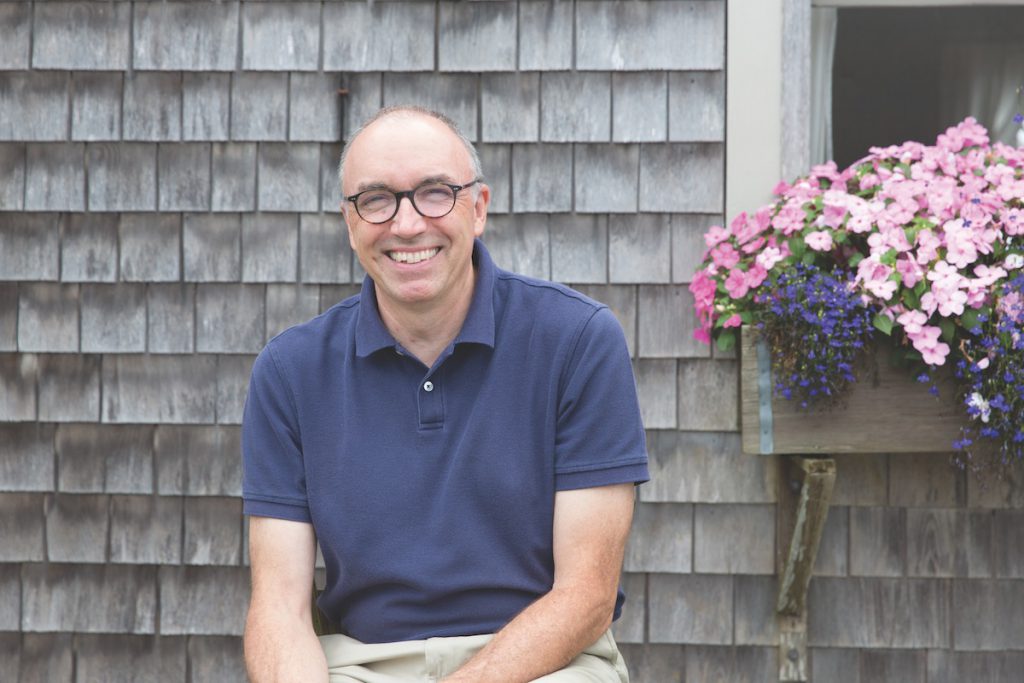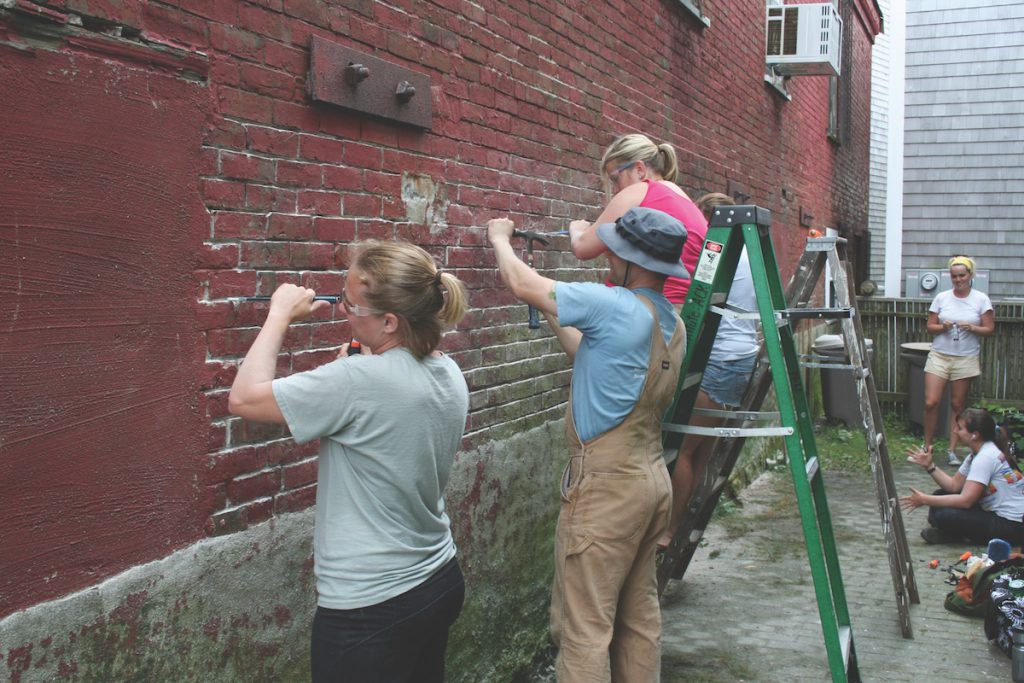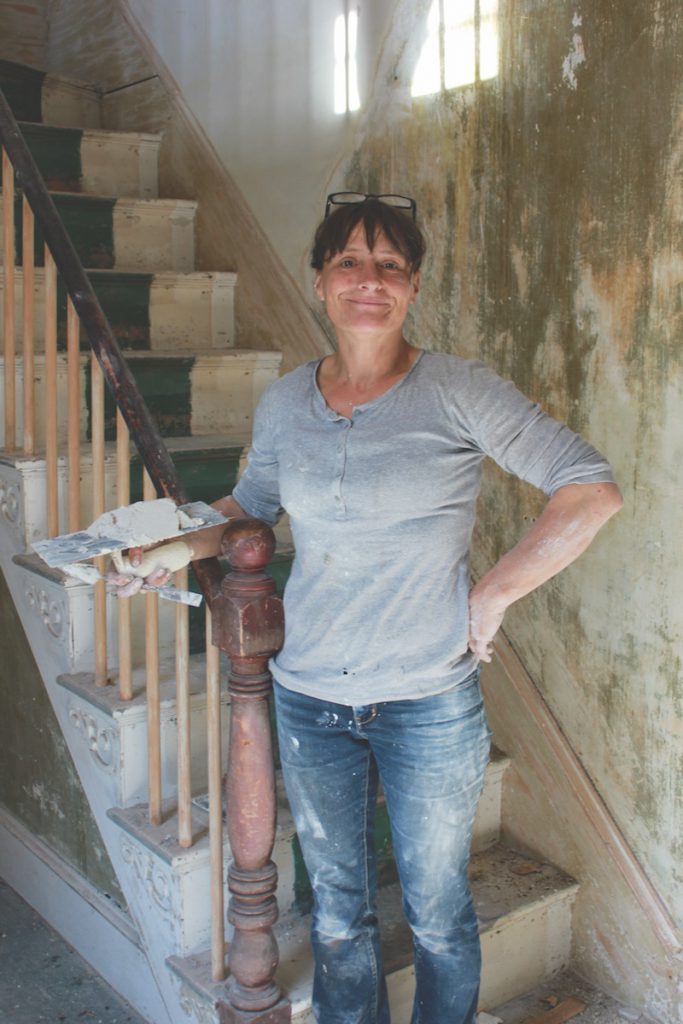It’s summer in Nantucket, and the hints of orange and blue mixed in among the tourists’ seersucker and straw hats are a sure sign that Gators are abroad on this history-soaked New England island.
The University of Florida students are here for an annual pilgrimage — Preservation Institute Nantucket — a field school more than a thousand miles north of UF’s Gainesville campus. The students will spend the summer developing new skills to document old spaces, all the while learning lessons in historic preservation.
Where better to learn than Nantucket, which boasts 800 pre-Civil War structures. The whole island is a National Historic Landmark District, and would appear to be frozen in time except for the crowds in prepster pastels and flip-flops, jamming the cobblestone lanes. Nantucket has been discovered, and as developers push to build, locals push to maintain the island’s character, making Nantucket a case study in historic preservation for eager UF students.
Director Morris “Marty” Hylton III, contributes to the orange-and-blue vibe, often donning a Gator baseball cap for field work. He says Preservation Institute Nantucket, or PIN, is ideal for teaching the nuances of historic preservation. It is not a fairy tale preservation story, with everyone pulling together in harmony, in homage to the past. It is a real-world community, where economic interests must be balanced against history, both for out-of-town developers and residents who find their land values skyrocketing and their shops and restaurants among the hottest tickets on the East Coast. In the real world, historic preservation does not take place in a vacuum, Hylton says, and that is keenly apparent in Nantucket.
“When we talk about preservation, people think about preservation as freezing these things in time,” says Hylton, an associate scholar and director of UF’s Historic Preservation Program. “But you’re always making decisions that impact the built environment; it is a creative process.”
The island could be on the brink of being loved to death, much like the nation’s other beloved, but fragile, landscapes. National parks saw visitation break records in 2016 for the third straight year, and Nantucket’s tourism and development show no signs of slowing. Who, after all, volunteers to sit out the iconic hike or the ferry ride to paradise?
“It never used to be this busy; that’s new in the last five years,” says Jacsin Finger, a year-round resident and deputy director of the Maria Mitchell Association, named for the nation’s first professional female astronomer. “We’re losing the historic fabric right and left.
“There are houses that PIN has documented in the last few years, quite a few, that have been obliterated on the inside,” Finger says. “If it weren’t for PIN, we wouldn’t have that documentation.”
Nantucket owes both its historic preservation and its tony status as a tourist destination to Walter Beinecke Jr., a businessman who recognized Nantucket’s special allure. PIN likely would not exist but for Beinecke finding a like-minded preservation ethic in F. Blair Reeves, a UF architecture professor from 1949 to 1987.

The two men crossed paths by happenstance. A federal historic preservation program designed to tap into the expertise of college professors and professionals sent Reeves to Nantucket in 1969. Beinecke and Reeves shared a common, holistic vision for documenting and preserving the urban and cultural landscape of the island. For the next three years, Beinecke asked Reeves to return, accompanied by enterprising students, to help with the huge task of documenting Nantucket’s motherlode of historic buildings. Nantucket, realizing the resource at hand, put out a welcome mat.
“The town kept asking us to come back,” Hylton says. “Today, the Gator Nation is a part of Nantucket.”
Beinecke and Reeves made the informal arrangement official, forming PIN in 1972. UF was among the first four universities to offer preservation studies, and PIN is the nation’s oldest continuously operating field school for historic preservation, with nearly 700 alumni from UF and over 120 other institutions of higher learning.
To date, the island boasts hundreds of structures in the Historic American Buildings Survey (HABS), many of them documented by PIN students, making the students a key resource in historic preservation on the island. PIN projects submitted to the Library of Congress have created an archive so large that there is more data on Nantucket than any other community in the nation.
Today, UF owns dorms for the students, three cottages for faculty and visiting lecturers, and the top floor of a Greek Revival building downtown called Sherburne Hall, which houses an open classroom, a library, a lab to study and analyze historic materials, such as mortar, and the latest technology.
Michael May, executive director of Nantucket Preservation Trust, says the students’ contribution to HABS — and Nantucket — is extraordinary.
“They’re only here during the summer months, but they make a huge impact,” May says.
Boom to Bust to Boom
In 1659, English settlers arrived to find the Wampanoag Indians on the “far-away island,” their name for Nantucket, which is 14 miles long and three to five miles wide and shaped like a boomerang pitched 30 miles out into the Atlantic Ocean.
Trees were scarce, so wood was precious and had to be shipped from the mainland, along with other building materials. Nantucketers became masters at reusing materials, wasting no board or brick or pane of glass in restoring or expanding a home. The ethic continues today — failure to recycle would make a Nantucketer a pariah — with the town dump in Madaket as much a recycling center as a waste disposal site. Islanders know if they are looking for something to check the dump, aka the Madaket Mall, first. Finger, a summer resident turned full-time resident 20 years ago, says her father once found a lovely oriental rug.

Local lore says a Nantucketer in 1690 looked offshore at the sea teeming with right whales and predicted Nantucket’s whaling future. The islanders harvested the sea, the global export of whale oil making them wealthy by colonial standards, although Nantucket’s Quaker roots kept ostentation to a minimum. The modest gray shingles of many Nantucket homes — and the island’s fog — gave rise to the nickname, Little Gray Lady of the Sea.
As the right whale fishery collapsed, the “Nantucket Navy” ventured from the Atlantic to the Pacific, catching the more oil-rich sperm whales. Their voyages sometimes took three years, and the growth of their families and gaps between births mirrored the timing of the whaling expeditions. The romance of Nantucket’s whalers caught the American imagination as well. Herman Melville based Moby-Dick on the disastrous real-life voyage of the whale ship Essex and its Nantucket crew.
Today’s Nantucket wears its history: cottages closely situated, so that families could lean on each other when their sons and husbands were away, and grand Greek Revival mansions that reflect the wealth that came from the whales. On Main Street, a visitor can stroll past the Three Bricks, three identical homes a whale oil merchant built for his three sons, so that they would not have to endure the hardships of whaling.
By 1850, whaling was the fifth largest industry in the U.S. By 1900, it was gone. When whaling collapsed, Nantucket’s isolation from the mainland kept it preserved from real estate activity. A surge in tourism at the turn of the century was offset by the Great Depression. By the time tourism ticked up again in the 1950s in the era of post-war sprawl, Beinecke had arrived on the scene, then Reeves, with his seasonal crew of eager UF students. With singular purpose, the two men believed historic preservation would be the key to Nantucket’s survival.
Their efforts were bolstered by federal historic preservation statutes enacted in the 1960s and by Nantucket’s own forward-looking preservation laws. Nantucket is the site of the nation’s first land bank, which started in 1983 and owns 2,000 of the island’s undeveloped 10,000 acres. About 50 percent of the island’s natural space is preserved.
That instinct to preserve natural spaces plays a role in the intense pressure today on Nantucket’s built environment. The scarcity of land has caused would-be residents to look to historic structures for their summer homes.
Preservation Inside and Out
In 2000, Nantucket was placed on the list of the 11 Most Endangered Historic Places by the National Trust for Historic Preservation. The influx of wealthy new residents looking for a summer hotspot had increased development pressure to the point that the island was losing chunks of its historic fabric, and it was happening, at first, without much notice.
From the outside, the cottages and homes look like a whaling family might walk out the door at any minute. Inside some, however, 21st century luxury has replaced the historic interiors. Ask a local if Nantucket’s claim to have 800 preserved pre-Civil War structures is still true, and they shrug. No one really knows. The Historic District Commission estimates 15 to 20 historic interiors may be destroyed each year.
Historic preservation rules strictly govern the outside of buildings. Behind closed doors, however, an owner can do whatever he chooses. Locals call it a gut rehab, and a Dumpster outside an 18th century cottage is a sure sign of heritage at risk, May says.

Hylton is passionate but reasonable. Modern Americans do not want to live in a museum or read by whale-oil lanterns. But he says much of the interiors can be preserved while providing for modern conveniences, such as master baths and dishwashers. The home at 1 York Street, one of the students’ documentation challenges of summer 2016, is a prime example.
Owner Pen Austin gave the students free run, and during the summer they came and went, along with workers and Austin herself. An architectural conservationist, Austin has worked on many historic renovations on the island, and each summer looks forward to the collaborations with the students. Her 1834 house was completely intact — “apart from windows switched out in 1920, such a shame” — and she began her renovation with reverence for the past.
“The philosophy is that you use the same dimensions, same wood, same materials for repairs that the house was built with. That way you’ve got compatible behavioral characteristics of the repair material with the original fabric, so things are going to move in the same way, behave in the same way,” says Austin, taking a break from repairing traditional, lime plaster walls. When she finishes the renovation, she will enter into a preservation easement with the Nantucket Preservation Trust, so even when she sells and moves on to the next project, the building will stay preserved.
“A lot of incredible interiors are just ending up in the Dumpsters,” Austin says. “It is heartbreaking.”
That makes PIN’s contribution all the more important, May says.
“What they’re doing now with the 3-D laser scanning has taken us to a different level, bringing 21st century technology to the island, and I think that’s really critical,” May says. “The island has always been in the forefront of preservation, so it makes sense that it’s happening, but it’s exciting to see that trend continuing. We needed a little boost, and I think the 3-D laser scanning is doing that. What they’re doing really is innovative.”
The laser scanning creates a 3-D virtual model that takes shape as a cloud of millions or hundreds of millions of tiny points. The digital models are used to document, preserve and interpret historic buildings and natural landmarks. PIN has an archive of decades of pen and ink elevations of the island’s heritage and is steadily adding the laser scans.
Sujin Kim, a doctoral candidate who taught classes in 2016 and 2017, but whose first trip to Nantucket was as a student in 2015, says PIN’s approach to using technology for heritage conservation gives the students — future preservation professionals — hands-on experience.

Last summer, students got a glimpse of the power of technology. They measured interior elevations for their headquarters at Sherburne Hall by hand, in teams, and produced drawings. It took the four teams all day to render the classroom. Then Kim had the students use the laser scanner. It took roughly three scans — about 30 minutes — to produce a 3D image, and allowed the students access to the upper reaches of the ceiling that they had not been able to measure by hand.
“Traditionally, in preservation, there has been a belief that you have to touch and smell things. Technology will not replace that, but it will assist,” Kim says. “We tell the students, they don’t have to remember every step of the software or technology, that could be obsolete next year. The important thing is to see the possibilities in the technology.”
PIN is also on the forefront of a trend to try to preserve interiors, avoiding the gut rehabs, Hylton and May say. Interiors are uncharted territory in a way. While many property owners embrace, and others grudgingly yield to, historic preservation of exteriors, walk through the front door, and it’s a different story.
“This is a tough issue, and it’s cutting edge in historic preservation,” May says. “People don’t have to open their doors.”
The question arises: at what point does interior gutting damage a home’s preservation status?
“What’s so unique about Nantucket is these interiors have remained for 200, 250 years,” May says. “People used to come to Nantucket and want to live differently than what we call America. Who cares if you have one bathroom, or don’t have a dishwasher? Now people are buying historic buildings and completely gutting the interior. That didn’t happen 20 years ago. One of the reasons you came here was the history.
“Now, it’s just the place to be.”
PIN students’ ambitious goal is to document the mostly residential interiors, using public records, among other archives. When they can gain access, as in Austin’s house, they gather more detailed data and do laser scanning, blending traditional preservation with modern preservation.
“We don’t have any real models to work off of, so we’re creating a model,” May says. “It’s a good partnership with the University of Florida.”
Beinecke’s daughter, Barbara Spitler, who still summers on Nantucket, remembers her father’s vision. He said Nantucket was different from Colonial Williamsburg, which operates as a living history museum, because it is a thriving town. And he wanted to save it from the kitschy tourism of Cape Cod.
“He cared about Nantucket,” Spitler says. “And he thought PIN was vital to keeping Nantucket preserved. Under Marty’s leadership, PIN has become a leader in historic preservation on the island.”
After seeing the potential in laser scanning, Spitler and others encouraged Hylton to ask the town for help to do more scanning, the first time PIN ever asked for aid. A couple of town leaders protested, asking why Nantucket would give money to a university in Florida. Finger recalls someone piped up: “You do realize they’ve been here for more than 40 years? They’re part of this community.” They got the funding.
As summer residents go, the PIN students are not the high rollers, yet their work may be a big part of the island’s future. One of the lessons they are learning is oddly contradictory: that even the best-preserved communities can be at risk.
“You can’t rewrite history,” Hylton says, “and you can’t undo changes.”
Photo Credits: Cary Hazlegrove and the Preservation Institute Nantucket
Source:
- Morris Hylton III, Director of the Historic Preservation Program
Related Website:
This article was originally featured in the Fall 2017 issue of Explore Magazine.

